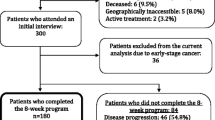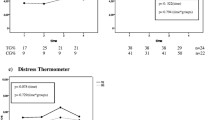Abstract
Goals of work
We report on the routine use of the NCCN Distress Thermometer and the Functional Assessment of Cancer Therapy—Brain (FACT-Br) to assess patient distress and quality of life in GBM patients. The purpose of this study was to examine the relationship between patient quality of life and distress.
Materials and methods
Data from 50 GBM patients presenting to a neuro-oncology clinic were evaluated. Descriptive statistics and correlations between the distress score and the FACT-Br subscale scores were generated.
Main results
The mean distress score was 2.15 (std 2.66), and 28.9% of brain tumor patients identified a distress score of 4 or above. The mean FACT-Br total was 127.34 (std 21.29), with patients scoring lowest in the EWB (18.95 std 4.4) and FWB (15.06 std 6.80) subscales. No differences between demographic groups were identified with regard to distress or quality of life. Statistically significant correlations were identified between the distress score and the SWB (R = −0.46, P = 0.001) and EWB (R = −0.56, P = 0.001) subscales of the FACT-Br. Fifty percent of participants who did not complete the FACT-Br reported clinically significant distress, but this did not differ significantly from participants who completed it.
Conclusions
Assessment of distress in brain tumor patients provides clinically relevant information and suggests interventions that may support quality of life. Further research is needed to explore the relationship between distress and quality of life. Current approaches to measuring quality of life in brain tumor patients may systematically undersample patients with advanced illness or significant psychosocial distress.

Similar content being viewed by others
References
Brown PD, Ballman KV, Rummans TA, Maurer MJ, Sloan JA, Boeve BF, Gupta L, Tang-Wai DF, Arusell RM, Clark MM, Buckner JC (2006) Prospective study of quality of life in adults with newly diagnosed high-grade gliomas. J Neurooncol 76:283–291 doi:10.1007/s11060-005-7020-9
Brown PD, Decker PA, Rummans TA, Clark MM, Frost MH, Ballman KV, Arusell RM, Buckner JC (2008) A prospective study of quality of life in adults with newly diagnosed high-grade gliomas: comparison of patient and caregiver ratings of quality of life. Am J Clin Oncol 31:163–168 doi:10.1097/COC.0b013e318149f1d3
Brown PD, Maurer MJ, Rummans TA, Pollock BE, Ballman KV, Sloan JA, Boeve BF, Arusell RM, Clark MM, Buckner JC (2005) A prospective study of quality of life in adults with newly diagnosed high-grade gliomas: the impact of the extent of resection on quality of life and survival. Neurosurgery 57:495–504 discussion 495–504 doi:10.1227/01.NEU.0000170562.25335.C7
Fine HA, Dear KB, Loeffler JS, Black PM, Canellos GP (1993) Meta-analysis of radiation therapy with and without adjuvant chemotherapy for malignant gliomas in adults. Cancer 71:2585–2597 doi:10.1002/1097-0142(19930415)71:8<2585::AID-CNCR2820710825>3.0.CO;2-S
Fox SW, Lyon D, Farace E (2007) Symptom clusters in patients with high-grade glioma. J Nurs Scholarsh 39:61–67 doi:10.1111/j.1547-5069.2007.00144.x
Giovagnoli AR, Silvani A, Colombo E, Boiardi A (2005) Facets and determinants of quality of life in patients with recurrent high grade glioma. J Neurol Neurosurg Psychiatry 76:562–568 doi:10.1136/jnnp.2004.036186
Huang ME, Wartella J, Kreutzer J, Broaddus W, Lyckholm L (2001) Functional outcomes and quality of life in patients with brain tumours: a review of the literature. Brain Inj 15:843–856 doi:10.1080/02699050010013653
Huang ME, Wartella JE, Kreutzer JS (2001) Functional outcomes and quality of life in patients with brain tumors: a preliminary report. Arch Phys Med Rehabil 82:1540–1546 doi:10.1053/apmr.2001.26613
Jacobsen PB, Donovan KA, Trask PC, Fleishman SB, Zabora J, Baker F, Holland JC (2005) Screening for psychologic distress in ambulatory cancer patients. Cancer 103:1494–1502 doi:10.1002/cncr.20940
Janda M, Steginga S, Dunn J, Langbecker D, Walker D, Eakin E (2008) Unmet supportive care needs and interest in services among patients with a brain tumour and their carers. Patient Educ Couns 71:251–258 doi:10.1016/j.pec.2008.01.020
Jones LW, Guill B, Keir ST, Carter K, Friedman HS, Bigner DD, Reardon DA (2007) Using the theory of planned behavior to understand the determinants of exercise intention in patients diagnosed with primary brain cancer. Psychooncology 16:232–240 doi:10.1002/pon.1077
Keir ST, Calhoun-Eagan RD, Swartz JJ, Saleh OA, Friedman HS (2008) Screening for distress in patients with brain cancer using the NCCN’s rapid screening measure. Psychooncology 17:621–625
Keir ST, Guill AB, Carter KE, Friedman HS (2006) Stress and intervention preferences of patients with brain tumors. Support Care Cancer 14:1213–1219 doi:10.1007/s00520-006-0087-9
Laack NN, Brown PD, Ivnik RJ, Furth AF, Ballman KV, Hammack JE, Arusell RM, Shaw EG, Buckner JC (2005) Cognitive function after radiotherapy for supratentorial low-grade glioma: a North Central Cancer Treatment Group prospective study. Int J Radiat Oncol Biol Phys 63:1175–1183 doi:10.1016/j.ijrobp.2005.04.016
Locke DE, Decker PA, Sloan JA, Brown PD, Malec JF, Clark MM, Rummans TA, Ballman KV, Schaefer PL, Buckner JC (2007) Validation of single-item linear analog scale assessment of quality of life in neuro-oncology patients. J Pain Symptom Manage 34:628–638 doi:10.1016/j.jpainsymman.2007.01.016
Osoba D, Aaronson NK, Muller M, Sneeuw K, Hsu MA, Yung WK, Brada M, Newlands E (1997) Effect of neurological dysfunction on health-related quality of life in patients with high-grade glioma. J Neurooncol 34:263–278 doi:10.1023/A:1005790632126
Passik SD, Donaghy KB, Theobald DE, Lundberg JC, Holtsclaw E, Dugan WM (2000) Oncology staff recognition of depressive symptoms on videotaped interviews of depressed cancer patients: implications for designing a training program. J Pain Symptom Manage 19:329–338 doi:10.1016/S0885-3924(00)00137-8
Passik SD, Dugan W, McDonald MV, Rosenfeld B, Theobald DE, Edgerton S (1998) Oncologists’ recognition of depression in their patients with cancer. J Clin Oncol 16:1594–1600
Pelletier G, Verhoef MJ, Khatri N, Hagen N (2002) Quality of life in brain tumor patients: the relative contributions of depression, fatigue, emotional distress, and existential issues. J Neurooncol 57:41–49 doi:10.1023/A:1015728825642
Portenoy R, Thaler H, Kornblith A, Lepore J, Friedlander-Klar H, Kiyasu E, Sobel K, Coyle N, Kemeny M, Norton L (1994) The Memorial Symptom Assessment Scale: an instrument for the evaluation of symptom prevalence, characteristics and distress. Eur J Cancer 30A:1326–1336 doi:10.1016/0959-8049(94)90182-1
Robe PA, Martin D, Albert A, Deprez M, Chariot A, Bours V (2006) A phase 1-2, prospective, double blind, randomized study of the safety and efficacy of sulfasalazine for the treatment of progressing malignant gliomas: study protocol of ISRCTN45828668. BMC Cancer 6:29 doi:10.1186/1471-2407-6-29
Salmaggi A, Silvani A, Merli R, Caroli M, Tomei G, Russo A, Riva M, Marchioni E, Imbesi F (2008) Multicentre prospective collection of newly diagnosed glioblastoma patients: update on the Lombardia experience. Neurol Sci 29:77–83 doi:10.1007/s10072-008-0865-x
Stupp R, Dietrich PY, Ostermann Kraljevic S, Pica A, Maillard I, Maeder P, Meuli R, Janzer R, Pizzolato G, Miralbell R, Porchet F, Regli L, de Tribolet N, Mirimanoff RO, Leyvraz S (2002) Promising survival for patients with newly diagnosed glioblastoma multiforme treated with concomitant radiation plus temozolomide followed by adjuvant temozolomide. J Clin Oncol 20:1375–1382 doi:10.1200/JCO.20.5.1375
Weitzner MA, Meyers CA, Gelke CK, Byrne KS, Cella DF, Levin VA (1995) The Functional Assessment of Cancer Therapy (FACT) scale. Development of a brain subscale and revalidation of the general version (FACT-G) in patients with primary brain tumors. Cancer 75:1151–1161 doi:10.1002/1097-0142(19950301)75:5<1151::AID-CNCR2820750515>3.0.CO;2-Q
Wrensch M, Minn Y, Chew T, Bondy M, Berger MS (2002) Epidemiology of primary brain tumors: current concepts and review of the literature. Neuro-oncol 4:278–299 doi:10.1215/15228517-4-4-278
Author information
Authors and Affiliations
Corresponding author
Rights and permissions
About this article
Cite this article
Kvale, E.A., Murthy, R., Taylor, R. et al. Distress and quality of life in primary high-grade brain tumor patients. Support Care Cancer 17, 793–799 (2009). https://doi.org/10.1007/s00520-008-0551-9
Received:
Accepted:
Published:
Issue Date:
DOI: https://doi.org/10.1007/s00520-008-0551-9




